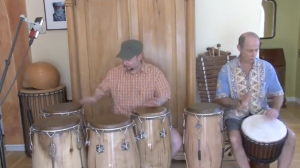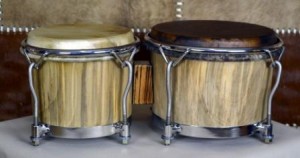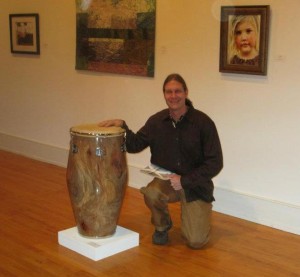 As you may all already know, or if you have seen any of my videos or posts, I am a huge fan of the Manito Percussion solid shell one peice congas, bongos and natural drum skins.
As you may all already know, or if you have seen any of my videos or posts, I am a huge fan of the Manito Percussion solid shell one peice congas, bongos and natural drum skins.
As a matter of fact, I have a set of Maple Ambrosia congas and also his black walnut bongos, too. I also use his skins on my large and ever expanding collection of congas, bongos and most recently a mule skin on my Drumskull Drums djembe as well.
I really enjoy talking and writing to Manito. For a one an show with a lot of orders he makes himself very available to customers. He always gives me great advice on what skins to use for different applications I may need. It is really nice in this day and age to be able to pick up the phone and call someone and speak to the actual person in charge. I find him to be exceptionally knowledgable, friendly and as you can see, (in the video links at the bottom of this page) a great player as well!
I thought it would be interesting for others to see and learn about the man behind these great products, to see his philosophy and explanations of how and why he does what he does. I really enjoyed interviewing him. I learned a lot and I hope you enjoy this as much as I did writing it.
What is your background and why congas (vs furniture/djembes, etc)

I was born in Cleveland, Ohio. When I was 4 years old, my family moved to Brasilia, Brasil. The city had literally been carved out of thick jungle 20 years earlier and the jungle seemed to have ideas about taking its land back.
The trees were massive old growth, teeming with amazing life. We had 4″ diameter vines growing over the front door that had to be trimmed on a weekly basis and the occasional coral snake that would end up in the living room.
Music was everywhere, on every corner, at all times of the day. Samba, batucada, capoeira, bossa nova… I remember me and my Dad taking a drive one day through the city and I realized that in such a musical country, you don’t need a radio- you just go outside and the rhythm surrounds you. I guess it got into my system early.
We moved back from Brasil to northwest Atlanta where I spent my high school years. I messed around with trumpet and guitar, but I always wanted to drum. When I got to college, I heard Los Muñequitos de Matanzas for the first time and that was it. My folks gave me a set of congas for my birthday and I started studying and practicing as much as I could. I honestly can’t explain why it was congas specifically that grabbed me, but I think it’s safe to say I was hooked.

How long have you been making congas what did you do before this?
I’ve been working on congas for about 20 years in one form or another. I started with the basics- mounting skins and fixing cracked staves. Before this, my Dad and I ran a home repair business doing everything from full renovations to building decks and screened porches. I miss working with him every day, but I had to follow my passion for drums. I’m working on getting him to come on board to build drums and other instruments with me. He’s a master craftsman in his own right.
What is the history of your drum company?
In the late 90’s and early 2000’s I had my first drum related company called Moyuba Drumworks. It

was mostly dedicated to sourcing skins and mounting them for all types of drums. I bought my first lathe during those early days and started making claves and sticks while learning the art of wood turning. A good friend had a conga which needed some new hardware, so I bought a welder and some basic metal working tools and set about learning to create hardware. I read every metal working and wood turning book I could get my hands on and spent the next ten years honing my skills.
In 2010 I had the opportunity to acquire a huge lathe and some custom built machinery. It was an opportunity I couldn’t pass up, so my Dad and I flew out to California, rented a moving truck to pick up the equipment and then drove home across the country. That was one of the best trips I have ever taken! My beautiful wife planned a scenic route for us and we camped and drove through some unbelievable country. When we got back to Georgia, I hit the ground running. I had 20+ congas in progress within a month and Manito Percussion was born. Life has pretty much been in high gear ever since.
Do you play drums? What styles of drumming do you play?
Yes I do! I’ve been playing and studying congas and Latin/Caribbean percussion since 1993. I had the

opportunity to study in Haiti with master drummer Frisner Agustin’s family and with Frisner himself here in the US on many occasions. I also used to spend my summers in Cuba studying with Justo Pelladito, Jose Eladio, and Alejandro Carbajal in La Habana as well as in Matanzas with Agustin Diaz, Esteban “Cha Cha ” Vega Bacallao, Daniel Alfonso, and Los Muñequitos de Matanzas.
I used to be in about 6 bands at a time, including being the director of ¡Moyuba! Drum Ensemble. I have also done quite a bit of studio and freelance work. With building drums, I don’t have the time to do all that anymore so I only really play with one band regularly, Orquesta Grogus based here in Athens, GA. We do a wide variety of music, mostly Cuban styles with some reggae, bossa, and old school funk mixed in. It’s a revolving lineup of amazing musicians and the shows can be anywhere from a quartet to a 12-15 piece orquesta.
Do you teach drumming as well?
I love teaching! I used to teach after school classes of third through fifth graders in Greenville, SC. We

opened up for baseball games, festivals, even got the kids on TV. I still have a few private conga students, but with all that it takes to build drums, I don’t have a lot of extra time anymore. I miss it, though- there’s nothing like that moment when you see a student really catch a piece of music and start to communicate with it.
Where do you source your wood from and why do you use the woods you use?
All of the wood I use for my drums is sourced locally and sustainably. I try to keep a low carbon footprint when sourcing wood and most of it comes from the urban forest surrounding Athens, GA. There are some amazing tone woods right in this area and staying in contact with local tree services allows me to get the best wood as it’s coming down. It can be a little tricky because I don’t go out into the forest and pick out trees to become drums.

I source the trees that are being being cut for other purposes and would otherwise be chipped up for mulch. The hardwoods I like to use (Rainbow Poplar, Maples, Walnut, Sycamore, Wild Cherry and many others) are all chosen for the best combination of tonality and visual beauty.
Every wood has a different characteristic tone and resonance. Some woods like Poplar work very well for folkloric situations where you want more mellow and smooth tones, while the Maples have a more bright sound, perfect for live stage setups.

My goal is to create visually stunning works of art that are unlike anything that has been seen before, while simultaneously crafting the finest possible instrument to the ears. Drums are an ancient and true art form, both building and playing them. There is so much to it. As a drummer and an artist, I think of my drums as sonic sculptures.
I incorporate the mathematics of harmony in the design of each drum and each set of drums while always trying to hone the visual aspect so that players know it’s going to sound beautiful before they play the first note. The main inspiration for my work is to make drums that are the complete package for the player, both visually and tonally.
Do you listen to the input from players?
Definitely. Players have been a huge help. I always listen to the input from players because they know what they want to hear. Of course, I have my own ideas and tastes, but as a custom drum builder it’s my challenge to craft instruments to meet their sound requirements. All custom musical instruments represent art with a deep purpose. If a drum looks good but doesn’t sound good to the player, it misses the mark and the player is the one who is left unhappy. I try to take the input from players and build them exactly what they are looking for.

What instruments do you currently offer? What future instruments will you be offering?
I offer Congas, Bongos, Barriles de Bomba, Haitian drums, Dununs, skins and mounted heads, claves and sticks, custom stainless steel hardware, lots of accessories and I do take special requests from time to time. My line of instruments is expanding and I’m always pushing the boundaries. I’m currently developing some small frame style drums, tamborims, pandeiros, panderetas, tambourines, etc. In the future I’d like to get more into making cajons, bata and even djembes.
There is much talk on the forums from owners and also many people I know who have had to wait for new custom or handmade drums and repairs from various drum makers and shops. Would you like to address why it takes so long?

Building these drums or any custom instrument is a very time consuming and difficult process. It requires an incredible amount of physical as well as mental labor and it is 100% a labor of love.
In my own process, I kiln dry every solid shell down past 8% moisture content. 8% MC is the international standard for fine furniture and kiln drying ensures that the finished shells don’t swell or move after they are sealed and clear coated. The drying process alone takes several months to complete correctly.

Also consider that when I design a new instrument, (like the bongos I introduced earlier this year) I must also design and build the very specialized tooling and machinery needed to make those instruments a reality. All those tools and machines require maintenance and sharpening, etc. and all of this is happening at the same time I’m filling other drum orders. There’s a lot going on!
I think the bottom line here is that the best things in life usually take a little while and they are always worth the wait.
How long is the waiting list for your drums?
Right now I have about a 6-8 month waiting period for custom drums, but it can vary depending on the

type of drum and how many orders I have at a given time. I keep claves, accessories, and skins in stock and usually complete custom hardware orders within 2-4 weeks.
What are your future plans?
I have notebooks full of new design ideas, but you’ll just have to wait and see what’s coming up! Rest assured I’m going to keep at it, expanding my horizons and my dedication to this craft every day. It’s a true blessing and I am so grateful for the opportunity to do this with my life!
Please click on the brown link right below to see and hear Manito playing his black walnut bongos.
http://www.youtube.com/watch?v=6dpiz76D_Rk&list=UUhGDIPWjmGO94ecSNDhwMiA
Please click on the brown link right below to see and hear Manito playing his red maple bongos.
http://www.youtube.com/watch?v=AlbFRUDfMbw

